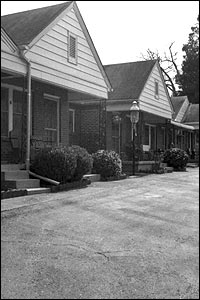Listed in Arkansas Register of Historic Places on 12/03/03
SUMMARY
The Gibson Court Historic District is being nominated under Criterion A with local significance as an important contributing district to highway and transportation-related architecture in Hot Springs,Arkansas between the years 1910–1965. Gibson Courtis a good example of a traditional tourist court on Park Avenue in Hot Springs, Arkansas. The district consists of the owner’s residence/office building and two buildings containing a total of 12 units, resulting in three contributing structures. Gibson Court has undergone alterations that make the building ineligible under Criterion C, but retains enough historic character to be listed under Criterion A.
ELABORATION
The Gibson Court evolved from a tourist camp to a tourist court during the reign of traveler services on Park Avenue. From approximately 1930 until 1940, Gibson Tourist Camp occupied the property at 903 Park Avenue.With the demand for more stable and secure lodging, courts were constructed on the property around 1940 to provide travelers with a roof over their heads and running water. Beginning with the completion of the paved Little Rock-Hot Springs highway (Highway 70) in 1925, Park Avenue being the final stretch into “the Spa City,” residents of Hot Springs and Park Avenue saw an opportunity to “make a buck” off the growing automobile traffic the highway guaranteed.In addition to being a convenient overnight stay en route to Dallas, Texas, Hot Springs thrived as a tourist destination.Known primarily for the healing powers of the thermal waters that flowed from its hillsides, Hot Springs also boasted alligator and ostrich farms, a horse-racing track, several theaters, and two amusement parks during its visitation peak.With the growth of automobile traffic, and the expansion of the city of Hot Springs in the 1930s–40s, travelers began looking for convenient and accessible overnight lodging near highways.The high-class downtown hotels could not offer on-site parking for the most part, and carried additional expenses such as porter’s fees for baggage handling and charges for clubs and social offerings.
As a result, traveler services, including tourist courts and service stations, began appearing along Park Avenue because of its proximity to Hot Springs’ major attractions and entertainment venues.The tourist courts along Park Avenue are generally a conglomeration of widely-circulated tourist court “plan books” and popular architectural styles of the period, with a little of the individual owner’s/builder’s personality thrown in for good measure.
The Gibson Court was built by Herman Gibson. Mr. Gibson owned the court until 1951 when ownership transferred to Charles. J. Latukas.By the early-1950s, medical advancements made drugs more readily available for ailments previously treated with thermal baths. Combine this with the rise in popularity of several recreational lakes south of Hot Springs, and tourists began to abandon the courts of Park Avenue.Like many, Gibson remained as tourist lodging throughout the 1950s, but became a casualty to the decline of travelers and tourists in Hot Springs, at which point the units were rented out as apartments.
Although the Gibson Court Historic District has undergone exterior alterations, the historic character is still plainly visible. This example of auto camp turned tourist court is important in understanding the progression of Park Avenue’s development of traveler services, and therefore makes the district eligible for Arkansas Registernomination under Criterion A.The nomination is being submitted under the multiple property listing "Arkansas Highway and Transportation Era Architecture, 1910-1965" in conjunction with the historic context "Arkansas Highway History and Architecture, 1910-1965."
BIBLIOGRAPHY
Baeder, John.Gas, Food, and Lodging:A Postcard Odyssey, Through the Great American Roadside.New York:Cross River Press, Ltd., 1982.
GarlandCountyTax Records, 1938 – 1953, 2000 – 2001.
Interview with Jill Curran, Director, Encyclopedia of Arkansas, August 2003.
Interview with Bobbie Jones McLean, Executive Director, GarlandCounty Historical Society, August 2003.
Hot SpringsCity Directory, 1930, 1938, 1940, 1942, 1944, 1948, 1951, 1953, 1955.
Jakle, John A, Keith A. Sculle, and JeffersonS. Rogers.The Motel inAmerica.Baltimore:The JohnsHopkinsUniversity Press,1996.
Liebs, Chester H.Main Street to Miracle Mile:American Roadside Architecture.Boston:Little, Brown and Company, 1985.
Margolies, John.Home Away From Home:Motels in America.Boston:Little, Brown and Company, 1995.
McAlester, Virginia and Lee.A Field Guide to American Houses.New York:Alfred A. Knopf, 1990.
Sanborn Insurance Company Maps - 1948, 1950.
